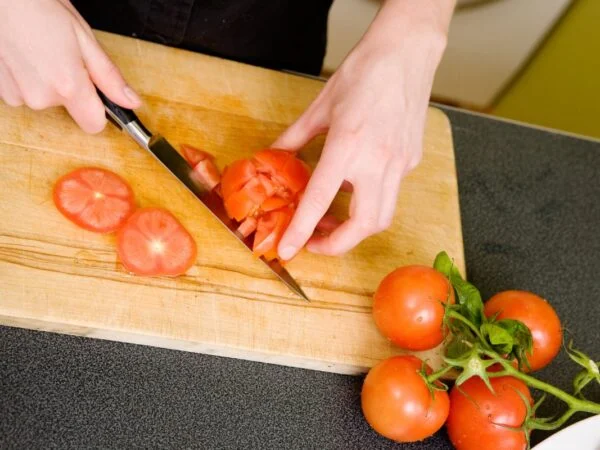Ditch the din of electric blenders and embrace the gentle, rhythmic clank of a food mill as it purees tomatoes to perfection. The old-school charm of this manual kitchen gadget lies in its ability to churn out velvety sauces while bidding farewell to pesky seeds and skin. Imagine your ripest tomatoes transformed without losing an ounce of their natural essence – that's the prowess of a food mill. With just a sprinkle of salt or a smattering of fresh herbs, you're not just milling; you're crafting flavors that store-bought cans can't hold a candle to. So grab those vibrant tomatoes, give them a quick prep, and let's get milling.
Selecting the Right Food Mill
Types of Food Mills
When choosing a food mill for tomatoes, consider the type you need. Manual crank models are perfect for those who enjoy traditional methods. They require hand-turning to process tomatoes but offer great control over speed and texture.
Electric food mills save time and effort. They work faster than manual models. This makes them ideal for large batches or frequent use.
Interchangeable discs are key features too. They let you adjust the coarseness of your puree. With these, you can move from fine to coarse textures easily.
Features for Tomatoes
For processing tomatoes, certain features in a food mill stand out:
-
Fine mesh screens make smooth purees without seeds or skin.
-
Sturdy handles ensure safe operation while cranking or pressing down.
-
Large bowl capacity is crucial when dealing with lots of tomatoes.
A good food mill will have these qualities to handle tomato pureeing effectively.
Steps to Use a Food Mill
Assembly Instructions
Before you start milling tomatoes, assemble your food mill. First, secure the milling disc and blade in place. This ensures that they won't move during use. Next, attach the handle properly for smooth rotation. A well-attached handle makes turning easier. Finally, lock the bowl in place to prevent any spills while you work.
To assemble correctly:
-
Ensure all parts are clean.
-
Fit the milling disc onto its base.
-
Place the blade on top of the disc.
-
Attach and tighten the handle.
-
Lock down the bowl securely.
Proper assembly is vital for effective use.
Milling Process
Now it's time to mill your tomatoes using consistent turns of the handle for even results. Add your tomatoes gradually; this helps avoid jamming up your food mill with too many at once. As you turn, apply gentle downward pressure to help push through and crush those juicy tomatoes into a perfect puree.
Here’s how to do it:
-
Turn steadily; don’t rush.
-
Add small amounts of tomatoes bit by bit.
-
Press down lightly as needed.
Consistent motion is key for a smooth puree.
Adjusting Consistency
For desired texture, choose an appropriate disc size before starting—larger holes yield chunkier sauce whereas smaller ones create finer textures. Regulate how fast or slow you turn the handle to control thickness; go slower for thicker purees or faster if you prefer it thinner. If necessary, re-mill your tomato puree until reaching that perfect consistency suited just right for your recipe needs.
Adjustment tips include:
-
Selecting correct disk size prior to starting
-
Modulating speed during milling
-
Re-milling if required
Texture control allows customization of final product.
Tips and Tricks for Tomato Milling
Achieving Smooth Puree
After you've set up your food mill using the steps from the previous section, it's time to focus on getting that perfect puree. Start by selecting a fine disc setting. This helps create a silkier texture in your tomato puree. As you turn the handle, push the tomatoes through thoroughly. Keep milling until you can't see any more chunks.
If an ultra-smooth consistency is what you're after, take an extra step: strain your puree. Use a fine mesh sieve to catch any tiny bits that escaped the mill. This will leave you with a smooth, velvety tomato base ideal for sauces and soups.
Handling Seeds and Skins
One of the great things about using a food mill is how it separates seeds and skins from your tomato flesh effortlessly. Once milling is complete, discard or compost these parts. They have served their purpose by giving flavor during cooking but are not pleasant to find in finished dishes.
During milling, make sure there's proper separation of seeds and skins from the pulp; this ensures no unwanted bits end up in your dish. If possible, opt for seedless tomato varieties when preparing meals requiring milled tomatoes—this reduces waste and simplifies preparation.
Simple Tomato Sauce with a Food Mill
Recipe Overview
After mastering the tips and tricks for tomato milling, you're ready to create a simple yet delicious tomato sauce. A food mill can help you achieve a smooth texture that's perfect for various dishes. Start by washing and coring your tomatoes, then cook them down slightly before passing them through the food mill to remove skins and seeds.
You can use this milled tomato base in several ways:
-
Enhance soups or stews with the fresh taste of tomatoes.
-
Whip up homemade ketchup that outshines store-bought versions.
The versatility of milled tomatoes is vast. For example, blend them into a soup for an easy meal or simmer with spices to make ketchup.
Cooking Techniques
To deepen the flavor of your sauce, let it simmer on low heat. This allows water to evaporate and tastes to concentrate. It's important not just for thickness but also for bringing out the natural sweetness of tomatoes.
Here are steps to add complexity to your sauce:
-
Sauté onions, garlic, or other aromatics until they're golden.
-
Add your milled tomatoes into the mix.
This technique infuses your sauce with aromatic flavors creating depth in every bite. Another method is blending cream into milled tomatoes after cooking them down—a tip if you desire creamy richness in dishes like pasta sauces or bisques.
Remember these points when using a food mill:
-
Cook down fresh tomatoes first.
-
Pass through the mill while still hot.
-
Simmer after milling for best results.
What to Make with a Food Mill
Versatile Recipes
A food mill's ability to create smooth, seedless tomato puree makes it ideal for various dishes. Marinara sauce is a classic choice. Start with milled tomatoes and add herbs for flavor. This base can transform into a hearty pasta topping or pizza sauce.
Gazpacho is another dish that shines with milled tomatoes. For this cold soup, blend fresh vegetables like cucumbers and peppers with the tomato juice from your food mill. The result is refreshing and perfect for hot days.
Tomato salsa combines textures beautifully when using both milled and diced ingredients. The milled tomatoes provide a saucy base, while chunks of onion, pepper, and cilantro add crunch.
-
Marinara Sauce: Smooth texture perfect for pasta.
-
Gazpacho: Cold soup enhanced by fresh tomato juice.
-
Tomato Salsa: A mix of textures from combined diced and milled components.
Nutritional Benefits
Using a food mill on tomatoes helps retain their natural goodness. Tomatoes are packed with vitamins A and C as well as minerals like potassium. Milling them preserves these nutrients better than commercial processing might.
The inclusion of pulp in your puree means you're also getting plenty of dietary fiber which aids digestion. Since the milling process doesn't involve heat, the raw nutritional value stays intact.
Furthermore, pureed tomatoes are low in calories but high in flavor—ideal for those watching their weight or managing specific health conditions such as diabetes or heart disease.
-
Preserves Vitamins/Minerals: Keeps raw nutrients intact.
-
Fiber-Rich Pulp: Promotes healthy digestion.
-
Low-Calorie Ingredient: Suitable for many diets including diabetic-friendly ones.
Food Mill vs. Food Processor
Texture Differences
A food mill offers unique benefits over a food processor, especially for tomatoes. One key advantage is the ability to achieve a chunky texture with coarser discs. This feature is perfect when you want your tomato dish to have more body and bite.
On the other hand, if you're aiming for a silky consistency, finer discs are your go-to choice. They work wonders in creating smooth sauces and soups where uniformity is desirable. The beauty of using a food mill lies in its versatility: it allows for customizable textures based on your cooking needs.
Use Cases
When summer's bounty brings heaps of ripe tomatoes, a food mill proves itself as an ideal tool for canning season's harvests. It efficiently separates seeds and skins from the pulp, leaving you with pure tomato goodness ready for jars.
But its use extends beyond just preserving tomatoes; it’s also quite handy when making baby food from fresh produce. A food mill ensures that fruits and vegetables are soft and safe enough even for the littlest diners.
Moreover, those who relish textured dishes like chutneys or relishes will find that a food mill assists beautifully in their creation. It breaks down ingredients while still maintaining some structure—perfect for these types of condiments.
Making Mashed Potatoes with a Food Mill
Preparation Steps
Before you start milling your potatoes, a few preparation steps are essential. First, make sure to sterilize your food mill. This is important for hygiene and will help prevent any bacteria from contaminating your mashed potatoes.
Next, if you're using ingredients that need softening—like potatoes—make sure they are pre-cooked until tender. This makes them easier to process through the mill.
Finally, have containers ready to catch the milled product as it comes out of the food mill. It's best to use bowls or pots that can hold all of the puree without spilling.
Consistency Tips
For smooth and creamy mashed potatoes, consistency is key. When cranking the handle of your food mill, try to maintain a consistent speed and pressure; this will help produce an even puree without lumps.
Be mindful not to overfill your food mill; too many ingredients at once can result in uneven textures since they won't be processed uniformly. If necessary, work in batches for better results.
To keep the puree consistent throughout milling, periodically clean off any buildup on the disc or blades of your food mill — just like how you'd scrape down sides when blending something thick in a processor mentioned earlier.
Purchasing a Food Mill
Where to Shop
You'll find food mills in many places. Kitchenware stores usually have them. These stores offer you a chance to see the mill before buying it. You can touch and feel the quality.
Online shops are another option. They have a wide selection of food mills. Plus, you can read what other buyers say about them in reviews.
For something special, try specialty cooking shops. They may sell high-end food mills that are hard to find elsewhere.
Price Range
Food mills vary in cost. A basic manual one won't set you back much money. It's good if you're on a budget but still want quality tomato puree.
If you spend more, premium models come with extras like finer sieves or easier grips which might be worth it for frequent use.
The price often reflects how long the mill will last and how much it can handle at once, as well as any added features it might include.
Using a Food Mill Effectively
Cleaning and Maintenance
After using your food mill for tomatoes, proper cleaning is key. Take apart the mill to clean each piece well. It's best to wash by hand instead of using a dishwasher. This keeps the parts in good shape longer.
Make sure every part is dry before you put it back together. This stops rust from forming. A food mill that's cared for will last many years.
Storage Solutions
When not in use, take your food mill apart and store it in a place that's dry and cool. Keep all pieces together so nothing gets lost. If there's room, hang the mill by its handle for quick access.
Storing your food mill correctly means it'll be ready when you need it next time.
Conclusion
Mastering the use of a food mill for tomatoes is like unlocking a culinary treasure chest; it's all about simplicity and flavor. You've now got the know-how to select the right gadget, turn those ripe tomatoes into velvety sauces, and even give mashed potatoes a gourmet twist. With your food mill as a trusty sidekick, say goodbye to seeds and skins, and hello to smooth, home-cooked goodness. It's not just about tomato sauce; your food mill is the gateway to a world of rustic soups, purées, and more.
Ready to roll up your sleeves and get milling? Dive into your kitchen adventure with confidence. Whip up that simple tomato sauce or explore new culinary creations. Your dishes will thank you—and so will your taste buds. So what are you waiting for? Grab that food mill, and let's get cooking!
Frequently Asked Questions
What is a food mill and why is it good for tomatoes?
A food mill separates seeds and skins while pureeing the flesh of tomatoes, giving you a smooth sauce effortlessly.
How do I choose the right food mill for my kitchen?
Opt for a sturdy food mill with interchangeable discs to handle various textures, ensuring versatility in your kitchen tasks.
Can you walk me through using a food mill with tomatoes?
Sure! Simply boil your tomatoes briefly, cool them down, then crank them through the food mill to separate the pulp from the skin and seeds.
Are there any special tips for milling tomatoes effectively?
Absolutely. Always start with ripe tomatoes and use gentle pressure when turning the handle to avoid splattering.
What's an easy tomato sauce recipe using a food mill?
For an easy sauce: Mill your boiled tomatoes, add salt, pepper, and herbs to taste; simmer until desired thickness is reached. Voilà!
When should I use a food processor instead of a food mill?
Use a processor if speed matters more than texture or if you need to chop rather than puree. For silky textures without seeds or skins—stick with the trusty old-fashioned way—a hand-cranked tool called "food mills".
Where can I buy a quality food mill?
Look no further than kitchenware stores or online retailers that specialize in cooking gadgets; they'll have plenty of options.
Image Source: Paid image from CANVA





